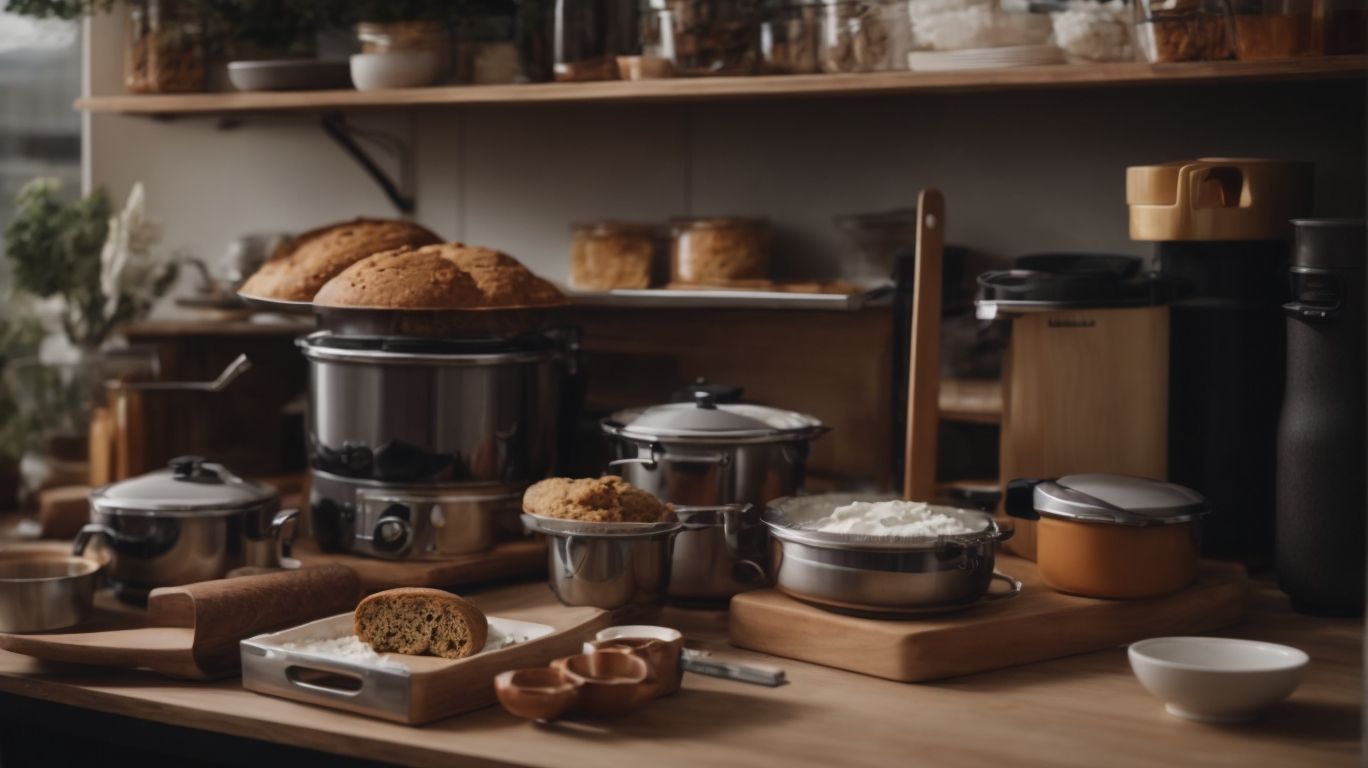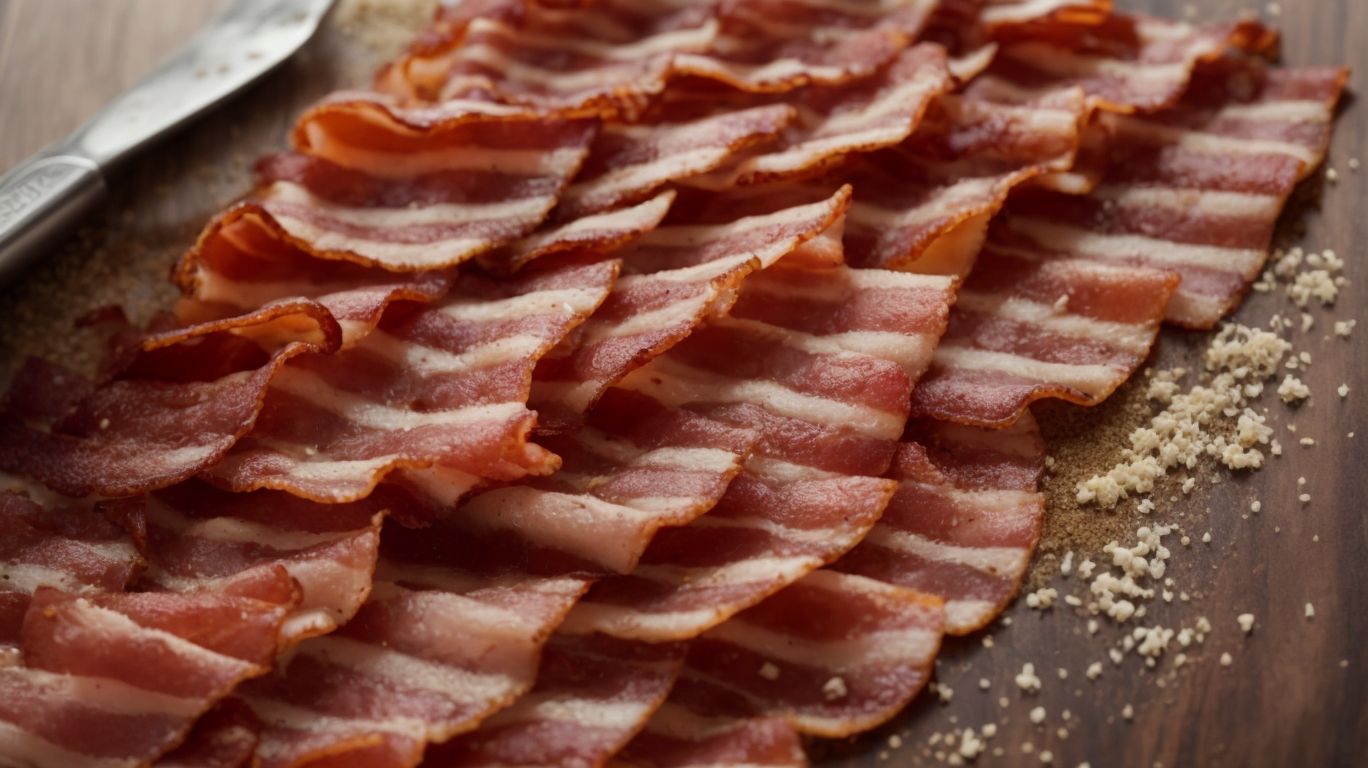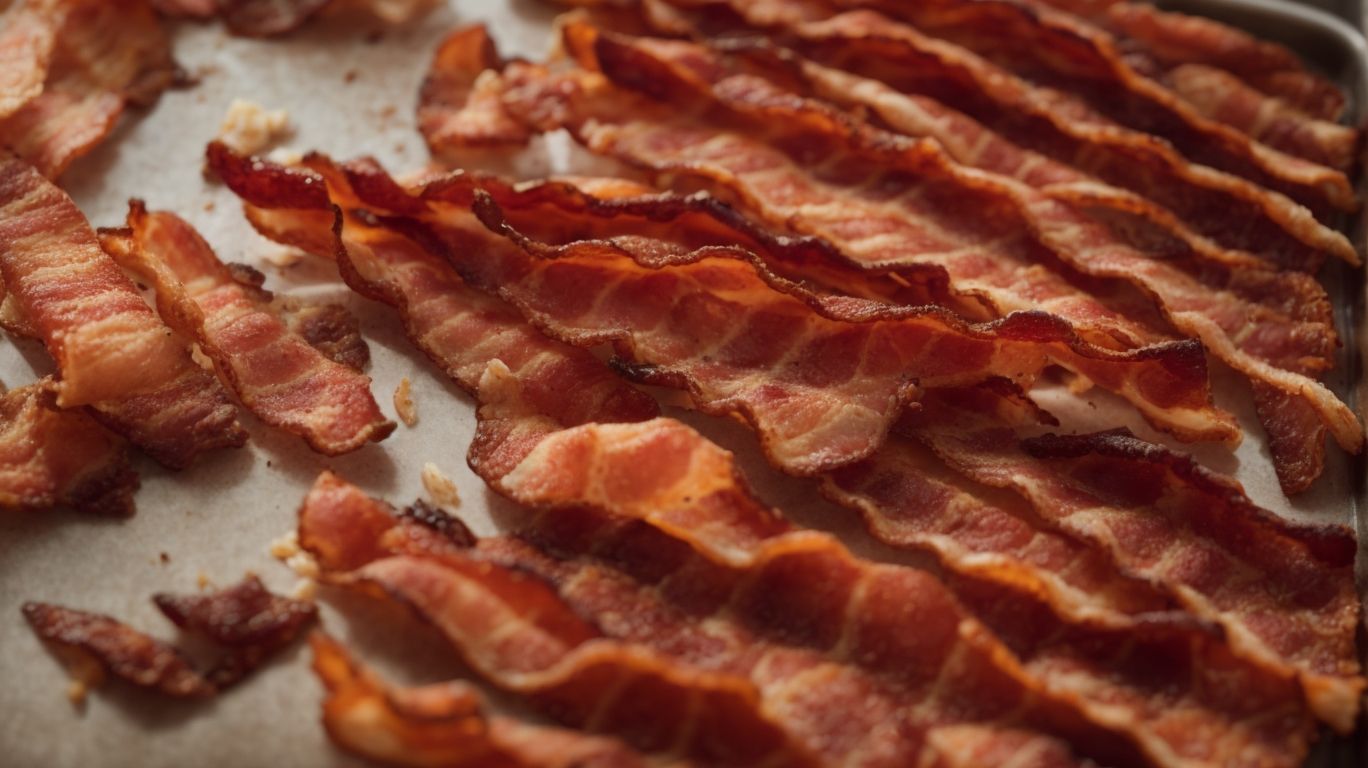How to Bake Bacon?
Are you tired of dealing with splattering grease and unevenly cooked bacon when frying it on the stovetop?
We will explore the benefits of baking bacon instead of frying it and guide you through the process step by step.
From selecting the right type of bacon to preparing it for baking and serving it up crispy and delicious, we’ve got you covered.
Learn how to perfect your bacon baking technique and elevate your breakfast game!
Key Takeaways:
Why Should You Bake Bacon Instead of Frying It?
Baking bacon instead of frying it offers numerous advantages, including achieving perfectly crispy bacon slices and minimizing the mess associated with stovetop cooking.
One advantage of baking bacon is the consistent heat distribution in the oven, ensuring that each slice cooks evenly. This eliminates the need for constant flipping, resulting in a hassle-free cooking process. Baking bacon reduces the chances of burning the slices, as the indirect heat helps control the cooking temperature. Another benefit is that baking allows the bacon fat to render out slowly, leading to a more controlled and even crisping of the strips.
What Type of Bacon Should You Use?
Selecting the right type of bacon is crucial for achieving the desired level of crispiness and flavor when baking in the oven.
One popular choice for baking is thick-cut bacon. With its extra thickness, it offers a robust texture and intense flavor, perfect for those who enjoy a meatier bite. Thick-cut bacon requires slightly longer baking times to ensure it reaches that perfect balance of crispy and chewy.
Another option is center-cut bacon, which is leaner compared to regular bacon. It still provides a delicious taste without as much fat, making it a healthier alternative for those watching their calorie intake. Center-cut bacon cooks more quickly than thick-cut varieties due to its leaner composition.
For a lighter option, turkey bacon is a great alternative. It’s typically lower in fat and calories than pork bacon, making it a suitable choice for health-conscious individuals. Turkey bacon tends to cook faster than traditional bacon, so be mindful not to overcook it to prevent it from becoming too dry.
Thick-cut Bacon
Thick-cut bacon, favored by bacon perfectionists, provides a hearty and substantial option for baking in the oven, resulting in perfectly crispy slices.
Its thickness allows it to retain its meaty texture and delicious flavor while cooking, making it a popular choice for culinary enthusiasts who appreciate a more robust taste profile.
When baked, thick-cut bacon develops a satisfying crunch on the outside, with just the right amount of chewiness inside, creating a delightful contrast in every bite.
Bacon aficionados are drawn to its ability to stand up well to other ingredients in dishes, adding a bold and savory element that enhances the overall flavor profile.
Center-cut Bacon
Center-cut bacon, known for its consistent thickness and leaner profile, is a versatile choice for baking and ensures high-quality results with every slice.
Regarding center-cut bacon, its even thickness makes it ideal for baking as it cooks evenly and crisps up beautifully. The leaner profile of center-cut bacon means less shrinking during the cooking process, resulting in meaty and flavorful slices.
- It is important to select high-quality center-cut bacon to enhance the overall taste and texture of your dishes.
- Whether you’re making bacon-wrapped appetizers, adding a savory element to pastries, or elevating the flavor of your favorite dishes, center-cut bacon is a versatile ingredient that can take your culinary creations to the next level.
Turkey Bacon
Turkey bacon, a lean alternative to traditional pork bacon, offers a lighter option for baking, producing flavorful results with reduced bacon fat on the baking sheet.
Regarding health-conscious cooking, turkey bacon is a popular choice due to its lower fat content and fewer calories compared to pork bacon. This makes it a great option for those looking to enjoy the delicious taste of bacon without the guilt.
By using a baking sheet to cook turkey bacon, you can achieve crispy and evenly cooked strips without excess grease. This method also allows for easy cleanup and is a convenient way to prepare a large batch of bacon for breakfast or as an ingredient in various dishes.
What Equipment Do You Need to Bake Bacon?

Credits: Poormet.Com – Samuel Thompson
Gathering the essential equipment, such as a reliable baking sheet, parchment paper, and aluminum foil, is crucial for successful bacon baking in the oven.
When choosing a durable baking sheet for baking bacon, opt for one that is heavy-duty and oven-safe to withstand high temperatures without warping. The parchment paper or aluminum foil plays a significant role in preventing the bacon from sticking to the pan, making cleanup easier, and ensuring even cooking. Parchment paper is preferred for its non-stick properties, while aluminum foil helps in trapping the bacon grease for a crispier finish.
Baking Sheet
A reliable baking sheet, preferably a rimmed baking sheet, serves as the foundation for successfully baking bacon in the oven, ensuring even cooking and minimal grease spillage.
Regarding baking bacon, having a quality baking sheet is key in achieving that perfect balance of crispy yet tender strips. The rimmed edges of the baking sheet play a crucial role in containing any grease that renders out during the cooking process, preventing it from overflowing and causing a mess in your oven.
The sturdy construction of a rimmed baking sheet ensures that heat is distributed evenly, resulting in uniformly cooked bacon strips without any burnt or undercooked spots. This consistency is essential for achieving that ideal texture and flavor that bacon enthusiasts crave.
Aluminum Foil or Parchment Paper
Using either aluminum foil or parchment paper on the baking sheet provides a non-stick surface for the bacon slices, facilitating easy cleanup and preventing sticking during the baking process.
These non-stick properties not only make cleaning up a breeze but also ensure that your bacon comes out perfectly cooked without leaving a mess behind. You no longer have to worry about scrubbing off burnt bits from the pan. By using parchment paper or aluminum foil, you create a barrier between the bacon and the pan, allowing for even heat distribution throughout the cooking process. This results in bacon that is uniformly crispy and delicious, without any chewy or undercooked spots.
Cooling Rack
A cooling rack placed over the baking sheet aids in draining excess bacon drippings and accumulating rendered bacon grease, enhancing the crispiness of the baked bacon slices.
By elevating the bacon slices above the baking sheet, the cooling rack allows the heat to circulate evenly, ensuring that each piece is cooked to crispy perfection. The slatted design of the rack promotes proper airflow, preventing the bacon from becoming soggy by allowing moisture to escape easily.
The collected bacon grease can be used for other recipes or disposed of conveniently, reducing mess and making cleanup a breeze. The use of a cooling rack not only improves the texture of the bacon but also enhances the overall cooking experience, making it a valuable tool for any bacon lover.
How to Prepare the Bacon for Baking?

Credits: Poormet.Com – Adam Smith
Properly preparing the bacon for baking involves preheating the oven, lining the baking sheet, and arranging the bacon slices evenly to ensure uniform cooking.
Start by preheating the oven to 400°F to ensure the bacon cooks evenly and becomes crispy without burning. Line a baking sheet with parchment paper or aluminum foil to catch the grease and prevent sticking for easier cleanup later on. Next, take the bacon slices and lay them out in a single layer on the prepared baking sheet, making sure they are not overlapping.
This step is crucial to allow the hot air in the oven to circulate around each slice, promoting even cooking and preventing the bacon from becoming soggy. By arranging the bacon slices evenly, you also ensure that they will all have direct contact with the hot surface of the baking sheet, resulting in that desired crispy texture.
Preheat the Oven
Preheating the oven to the recommended temperature is crucial to ensure that the bacon cooks evenly and achieves the desired level of crispiness within the specified cooking time.
When the oven is preheated properly, it allows the bacon to start cooking immediately upon placement on the baking tray, promoting even distribution of heat. This even cooking process not only enhances the bacon’s flavor but also ensures that it reaches the perfect balance of tenderness and crispiness. Preheating the oven helps reduce the overall cooking time, as the bacon starts cooking at the intended temperature right from the beginning, streamlining the entire baking process.
Line the Baking Sheet
Lining the baking sheet with parchment paper ensures easy clean-up post-cooking, prevents sticking, and promotes even cooking of the bacon slices.
When using parchment paper to line the baking sheet for baking bacon, you create a non-stick surface that helps in effortlessly removing the crispy bacon strips. The paper absorbs excess grease during the cooking process, making cleaning up a breeze without the need for scrubbing or soaking. The parchment paper aids in distributing heat evenly, ensuring that each slice of bacon cooks uniformly and to perfection. This method not only simplifies the cooking process but also enhances the overall taste and texture of the bacon.
Arrange the Bacon on the Sheet
Carefully arranging the bacon slices on the sheet in a single layer promotes even cooking and results in perfectly baked bacon with a consistent texture.
When you lay out the bacon strips properly, with each one having its own space on the baking sheet, it allows the heat to distribute evenly during the baking process. This helps in achieving a crispy texture throughout each piece, avoiding any parts being overly chewy or undercooked. A uniform layer of bacon ensures that each slice receives the same amount of heat, resulting in a consistent outcome every time. Whether you prefer your bacon extra crispy or slightly chewy, this technique is key to achieving your desired texture.
What Are the Steps for Baking Bacon?
Baking bacon involves key steps such as baking at high temperatures, draining excess bacon grease, and returning the bacon to the oven for achieving optimal crispiness.
When baking bacon, it is important to preheat the oven to around 400°F (200°C) to ensure that the bacon cooks evenly and becomes crispy. By placing the bacon strips on a wire rack on a baking sheet, you allow the excess fat to drip off, resulting in a less greasy final product. After the initial baking time, you can assess the crispiness and decide whether to return the bacon to the oven for additional baking to achieve the desired level of crunchiness.
Bake at High Temperature
Baking bacon at a high temperature of around 400 degrees Fahrenheit using the oven method accelerates the cooking process and ensures the bacon reaches the desired level of crispiness.
To start the process, begin by preheating your oven to the specified temperature of 400 degrees Fahrenheit. While the oven is heating up, prepare a baking sheet by lining it with parchment paper or aluminum foil to prevent the bacon from sticking.
Once the oven reaches the desired temperature, lay out the bacon strips evenly on the baking sheet, making sure they are not overlapping. This ensures that each strip cooks evenly and becomes crispy. Placing the bacon in a preheated oven allows for quick cooking, resulting in perfectly crispy bacon in a shorter amount of time.
Drain the Bacon Grease
Draining the rendered bacon grease into a glass jar post-baking not only reduces excess fat content but also offers a flavorful ingredient for future culinary endeavors.
By allowing the bacon grease to cool slightly before handling, you can mitigate any risk of burns or spills. Once transferred into the glass jar, ensure it is tightly sealed to maintain freshness and prevent odors from permeating your kitchen.
This liquid gold of the culinary world can be used in numerous ways; from enhancing the flavor of vegetables or soups to imparting a rich depth to dressings or popcorn, it adds a savory touch to an array of dishes. Its versatility knows no bounds, making it a staple in both traditional and experimental cooking.
Return to the Oven for Crispy Bacon
Returning the bacon to the oven for a brief period after draining excess grease enhances its crispiness and texture, ensuring a perfectly cooked bacon experience within the specified cook time.
This final step is crucial to achieving that ideal balance of crispiness and tenderness in your bacon. Once you have drained the grease, carefully place the bacon back in the oven at a high temperature. This quick return to the heat helps to further render the fat and create that irresistible crunch.
Monitor the bacon closely during this stage to prevent overcooking. By keeping a close eye on the color and texture, you can ensure that your bacon is cooked to perfection without becoming overly dry or burnt.
How to Serve and Store Baked Bacon?
After baking bacon, it is essential to consider serving suggestions, proper storage methods, and effective reheating tips to maintain its flavor and texture.
Regarding serving baked bacon, think beyond the traditional breakfast plate. Try incorporating it into sandwiches, salads, or even pasta dishes for an added savory kick. You can also get creative with bacon-wrapped appetizers or crumble it over dishes for a crunchy topping.
For storing baked bacon, ensure it cools completely before transferring it to an airtight container or sealed plastic bag. Refrigerate the bacon within two hours of baking to maintain freshness. To stay organized, consider storing the bacon strips in a single layer to prevent them from sticking together.
When reheating bacon, avoid using the microwave, as it can make the bacon soggy. Instead, opt for methods like heating it in a skillet or oven for crispy results. Place the bacon on a paper towel-lined plate to absorb excess oil and maintain its crunch.
Serving Suggestions
Incorporate crispy baked bacon slices as a delightful topping for salads, enhancing their flavor profiles with a crunchy and savory addition.
When using baked bacon slices as salad toppings, consider chopping them into small pieces to distribute the flavor evenly. The crispy texture of the bacon contrasts beautifully with softer salad ingredients, providing a satisfying crunch in every bite.
For a burst of salty richness, try crumbling the baked bacon over a Caesar salad or a spinach salad with strawberries and feta cheese. The smoky notes from the bacon can also complement the sweetness of fruits like apples or pears in a mixed green salad.
Proper Storage
Store the cooled bacon slices on a paper towel-lined plate to absorb excess grease and ensure they remain fresh; consider refrigerating rendered bacon grease for future culinary applications.
Placing the bacon on a paper towel-lined plate allows the excess grease to be drawn away, preventing sogginess and maintaining crispiness. It’s essential to avoid stacking the slices to ensure proper air circulation. After cooling, transfer the plate to the refrigerator for longer-term storage.
Regarding the rendered bacon grease, refrigerating it in a sealed container can prolong its shelf life and preserve its flavor. This flavorful grease can be used for cooking various dishes, adding a rich and smoky dimension to your culinary creations.
Reheating Tips
When reheating baked bacon, utilize a moderate oven temperature to retain its crispiness and flavor, ensuring that the bacon slices are heated evenly for a satisfying culinary experience.
It is crucial to preheat the oven to around 325°F (163°C) before placing the bacon slices on a lined baking sheet. This initial step helps in achieving consistent heating throughout the strips and prevents them from becoming overly greasy or rubbery.
For optimal results, consider covering the baking sheet with aluminum foil while reheating the bacon. This not only aids in preserving its moisture but also helps in maintaining its desirable texture.
To prevent the bacon from drying out, you can add a drizzle of maple syrup or honey on top of the slices before placing them in the oven. This simple addition enhances the overall flavor profile and keeps the bacon juicy.
Frequently Asked Questions
What is the best temperature to bake bacon?
The ideal temperature for baking bacon is 400 degrees Fahrenheit. This allows the bacon to cook evenly and become crispy without burning.
How long does it take to bake bacon?
Baking bacon usually takes about 15-20 minutes. However, the cooking time may vary depending on the thickness of the bacon and the desired level of crispiness.
Can I use a baking sheet or do I need a special pan for baking bacon?
You can use a regular baking sheet to bake bacon. However, using a pan with a wire rack can help the bacon cook more evenly and prevent it from sitting in its own grease.
Do I need to flip the bacon while baking?
No, you do not need to flip the bacon while baking. The heat from the oven will cook both sides of the bacon evenly.
How do I prevent bacon from splattering in the oven?
To prevent bacon from splattering in the oven, line your baking sheet with foil or parchment paper. This will catch any grease and make for easier cleanup.
Can I bake bacon ahead of time and reheat it later?
Yes, you can bake bacon ahead of time and reheat it later. Simply store the cooked bacon in an airtight container in the fridge and reheat in the microwave or oven for a quick breakfast option.

